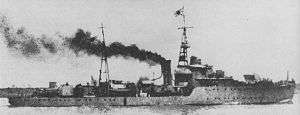Japanese gunboat Uji (1940)
Uji (宇治) was the second and final vessel in the Hashidate-class gunboats in the Imperial Japanese Navy, that operated in China during the 1940s.
 Uji on the Yangtze River, 1941 | |
| History | |
|---|---|
| Name: | Uji |
| Ordered: | 1937 |
| Builder: | Osaka Iron Works |
| Laid down: | January 20, 1940 |
| Launched: | September 29, 1940 |
| Completed: | April 30, 1941 |
| Stricken: | October 25, 1945 |
| Fate: | prize of war to China, September 13, 1945 |
| Name: | Chang Zhi |
| Acquired: | 19 September 1945 |
| Stricken: | 22 September 1949 |
| Fate: | captured by PRC in Chinese Civil War |
| Name: | Chang Zhi--> Nan Chang |
| Acquired: | 19 September 1949 |
| Fate: | scrapped in 1980s |
| General characteristics | |
| Type: | gunboat |
| Displacement: | 993 long tons (1,009 t) |
| Length: | 78.5 m (258 ft) |
| Beam: | 9.7 m (31 ft 10 in) |
| Draught: | 2.45 m (8 ft 0 in) |
| Propulsion: | 4,600 hp (3,400 kW) geared turbine |
| Speed: | 19.5 knots (22.4 mph; 36.1 km/h) |
| Range: | 2,500 nmi / 14 kn |
| Complement: | 158 |
| Armament: |
|
History
Uji was authorized under the Maru-3 Naval Expansion Budget of 1937. She was laid down at Osaka Iron Works on January 20, 1940 and launched on September 29, 1940, and was commissioned into the Japanese Navy as on April 30, 1941.[1] She was intended initially for support of combat operations by the Imperial Japanese Army in the Second Sino-Japanese War off the coast of China. At the time of the attack on Pearl Harbor, Hashidate was assigned to the China Area Fleet as part of the 1st China Expeditionary Fleet’s 11th Escort Group.[1] At some point in 1943, five additional Type 96 25 mm AT/AA Guns were added, along with depth charges in 1944. She remained based in the Shanghai area, patrolling the lower reaches of the Yangtze River throughout most of World War II On April 21, 1944, she was assigned to the Take Convoy mission to transport the Imperial Japanese Army’s IJA 32nd Division and IJA 35th Division from China via Takao, Keelung, and Manila to New Guinea. The convoy was attacked by USS Spearfish (SS-190) in the East China Sea and Uji was detached to escort the damaged fleet supply ship Mamiya to Moji, arriving on May 9. In August, 1944, she departed Moji for convoy escort to Taiwan and Okinawa, returning to Shanghai in January 1945.
After the surrender of Japan, she was transferred as a prize of war to the Republic of China Navy, and renamed Chang Chi (長治) on September 13, 1945, but was not formally removed from the Japanese navy list until October 25, 1945. At some point in 1949, she was captured by the People’s Liberation Army Navy and rearmed in 1955 with Soviet supplied weaponry and renamed as Nan Chang (南昌).
Notes
- Nevitt, Allyn D. (1997). "IJN Uji: Tabular Record of Movement". Combinedfleet.com.
References
- Jentsura, Hansgeorg (1976). Warships of the Imperial Japanese Navy, 1869-1945. Naval Institute Press. ISBN 0-87021-893-X.
- Watts, Anthony J (1967). Japanese Warships of World War II. Doubleday. ISBN 978-0-3850-9189-3.
- Chesneau, Roger (1979). Conway's All the World's Fighting Ships. London: Conway Maritime Press. ISBN 0-85177-133-5.
External links
- Nevitt, Allyn D. (1997). "IJN Hashidate: Tabular Record of Movement". Combinedfleet.com.